Zhedong Zheng
AnomalyLMM: Bridging Generative Knowledge and Discriminative Retrieval for Text-Based Person Anomaly Search
Sep 04, 2025Abstract:With growing public safety demands, text-based person anomaly search has emerged as a critical task, aiming to retrieve individuals with abnormal behaviors via natural language descriptions. Unlike conventional person search, this task presents two unique challenges: (1) fine-grained cross-modal alignment between textual anomalies and visual behaviors, and (2) anomaly recognition under sparse real-world samples. While Large Multi-modal Models (LMMs) excel in multi-modal understanding, their potential for fine-grained anomaly retrieval remains underexplored, hindered by: (1) a domain gap between generative knowledge and discriminative retrieval, and (2) the absence of efficient adaptation strategies for deployment. In this work, we propose AnomalyLMM, the first framework that harnesses LMMs for text-based person anomaly search. Our key contributions are: (1) A novel coarse-to-fine pipeline integrating LMMs to bridge generative world knowledge with retrieval-centric anomaly detection; (2) A training-free adaptation cookbook featuring masked cross-modal prompting, behavioral saliency prediction, and knowledge-aware re-ranking, enabling zero-shot focus on subtle anomaly cues. As the first study to explore LMMs for this task, we conduct a rigorous evaluation on the PAB dataset, the only publicly available benchmark for text-based person anomaly search, with its curated real-world anomalies covering diverse scenarios (e.g., falling, collision, and being hit). Experiments show the effectiveness of the proposed method, surpassing the competitive baseline by +0.96% Recall@1 accuracy. Notably, our method reveals interpretable alignment between textual anomalies and visual behaviors, validated via qualitative analysis. Our code and models will be released for future research.
Uncertainty-o: One Model-agnostic Framework for Unveiling Uncertainty in Large Multimodal Models
Jun 09, 2025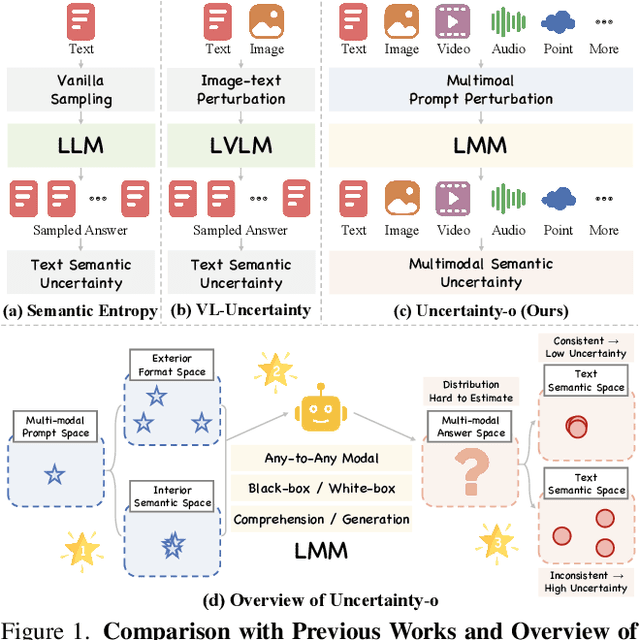
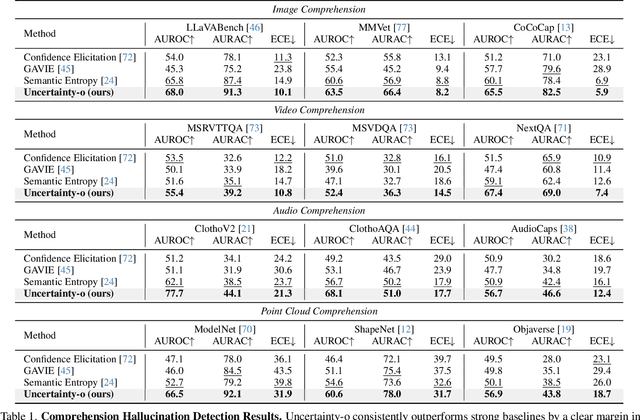
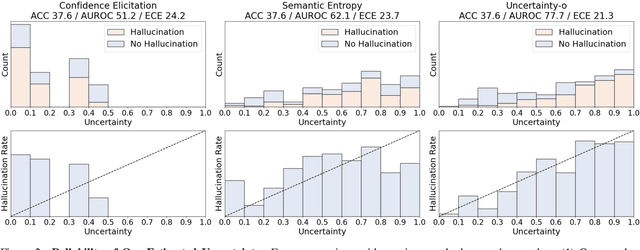

Abstract:Large Multimodal Models (LMMs), harnessing the complementarity among diverse modalities, are often considered more robust than pure Language Large Models (LLMs); yet do LMMs know what they do not know? There are three key open questions remaining: (1) how to evaluate the uncertainty of diverse LMMs in a unified manner, (2) how to prompt LMMs to show its uncertainty, and (3) how to quantify uncertainty for downstream tasks. In an attempt to address these challenges, we introduce Uncertainty-o: (1) a model-agnostic framework designed to reveal uncertainty in LMMs regardless of their modalities, architectures, or capabilities, (2) an empirical exploration of multimodal prompt perturbations to uncover LMM uncertainty, offering insights and findings, and (3) derive the formulation of multimodal semantic uncertainty, which enables quantifying uncertainty from multimodal responses. Experiments across 18 benchmarks spanning various modalities and 10 LMMs (both open- and closed-source) demonstrate the effectiveness of Uncertainty-o in reliably estimating LMM uncertainty, thereby enhancing downstream tasks such as hallucination detection, hallucination mitigation, and uncertainty-aware Chain-of-Thought reasoning.
Echo Planning for Autonomous Driving: From Current Observations to Future Trajectories and Back
May 25, 2025Abstract:Modern end-to-end autonomous driving systems suffer from a critical limitation: their planners lack mechanisms to enforce temporal consistency between predicted trajectories and evolving scene dynamics. This absence of self-supervision allows early prediction errors to compound catastrophically over time. We introduce Echo Planning, a novel self-correcting framework that establishes a closed-loop Current - Future - Current (CFC) cycle to harmonize trajectory prediction with scene coherence. Our key insight is that plausible future trajectories must be bi-directionally consistent, ie, not only generated from current observations but also capable of reconstructing them. The CFC mechanism first predicts future trajectories from the Bird's-Eye-View (BEV) scene representation, then inversely maps these trajectories back to estimate the current BEV state. By enforcing consistency between the original and reconstructed BEV representations through a cycle loss, the framework intrinsically penalizes physically implausible or misaligned trajectories. Experiments on nuScenes demonstrate state-of-the-art performance, reducing L2 error by 0.04 m and collision rate by 0.12% compared to one-shot planners. Crucially, our method requires no additional supervision, leveraging the CFC cycle as an inductive bias for robust planning. This work offers a deployable solution for safety-critical autonomous systems.
CAMeL: Cross-modality Adaptive Meta-Learning for Text-based Person Retrieval
Apr 26, 2025Abstract:Text-based person retrieval aims to identify specific individuals within an image database using textual descriptions. Due to the high cost of annotation and privacy protection, researchers resort to synthesized data for the paradigm of pretraining and fine-tuning. However, these generated data often exhibit domain biases in both images and textual annotations, which largely compromise the scalability of the pre-trained model. Therefore, we introduce a domain-agnostic pretraining framework based on Cross-modality Adaptive Meta-Learning (CAMeL) to enhance the model generalization capability during pretraining to facilitate the subsequent downstream tasks. In particular, we develop a series of tasks that reflect the diversity and complexity of real-world scenarios, and introduce a dynamic error sample memory unit to memorize the history for errors encountered within multiple tasks. To further ensure multi-task adaptation, we also adopt an adaptive dual-speed update strategy, balancing fast adaptation to new tasks and slow weight updates for historical tasks. Albeit simple, our proposed model not only surpasses existing state-of-the-art methods on real-world benchmarks, including CUHK-PEDES, ICFG-PEDES, and RSTPReid, but also showcases robustness and scalability in handling biased synthetic images and noisy text annotations. Our code is available at https://github.com/Jahawn-Wen/CAMeL-reID.
Every Painting Awakened: A Training-free Framework for Painting-to-Animation Generation
Mar 31, 2025Abstract:We introduce a training-free framework specifically designed to bring real-world static paintings to life through image-to-video (I2V) synthesis, addressing the persistent challenge of aligning these motions with textual guidance while preserving fidelity to the original artworks. Existing I2V methods, primarily trained on natural video datasets, often struggle to generate dynamic outputs from static paintings. It remains challenging to generate motion while maintaining visual consistency with real-world paintings. This results in two distinct failure modes: either static outputs due to limited text-based motion interpretation or distorted dynamics caused by inadequate alignment with real-world artistic styles. We leverage the advanced text-image alignment capabilities of pre-trained image models to guide the animation process. Our approach introduces synthetic proxy images through two key innovations: (1) Dual-path score distillation: We employ a dual-path architecture to distill motion priors from both real and synthetic data, preserving static details from the original painting while learning dynamic characteristics from synthetic frames. (2) Hybrid latent fusion: We integrate hybrid features extracted from real paintings and synthetic proxy images via spherical linear interpolation in the latent space, ensuring smooth transitions and enhancing temporal consistency. Experimental evaluations confirm that our approach significantly improves semantic alignment with text prompts while faithfully preserving the unique characteristics and integrity of the original paintings. Crucially, by achieving enhanced dynamic effects without requiring any model training or learnable parameters, our framework enables plug-and-play integration with existing I2V methods, making it an ideal solution for animating real-world paintings. More animated examples can be found on our project website.
A Large-scale Interpretable Multi-modality Benchmark for Facial Image Forgery Localization
Dec 27, 2024Abstract:Image forgery localization, which centers on identifying tampered pixels within an image, has seen significant advancements. Traditional approaches often model this challenge as a variant of image segmentation, treating the binary segmentation of forged areas as the end product. We argue that the basic binary forgery mask is inadequate for explaining model predictions. It doesn't clarify why the model pinpoints certain areas and treats all forged pixels the same, making it hard to spot the most fake-looking parts. In this study, we mitigate the aforementioned limitations by generating salient region-focused interpretation for the forgery images. To support this, we craft a Multi-Modal Tramper Tracing (MMTT) dataset, comprising facial images manipulated using deepfake techniques and paired with manual, interpretable textual annotations. To harvest high-quality annotation, annotators are instructed to meticulously observe the manipulated images and articulate the typical characteristics of the forgery regions. Subsequently, we collect a dataset of 128,303 image-text pairs. Leveraging the MMTT dataset, we develop ForgeryTalker, an architecture designed for concurrent forgery localization and interpretation. ForgeryTalker first trains a forgery prompter network to identify the pivotal clues within the explanatory text. Subsequently, the region prompter is incorporated into multimodal large language model for finetuning to achieve the dual goals of localization and interpretation. Extensive experiments conducted on the MMTT dataset verify the superior performance of our proposed model. The dataset, code as well as pretrained checkpoints will be made publicly available to facilitate further research and ensure the reproducibility of our results.
Relative Distance Guided Dynamic Partition Learning for Scale-Invariant UAV-View Geo-Localization
Dec 23, 2024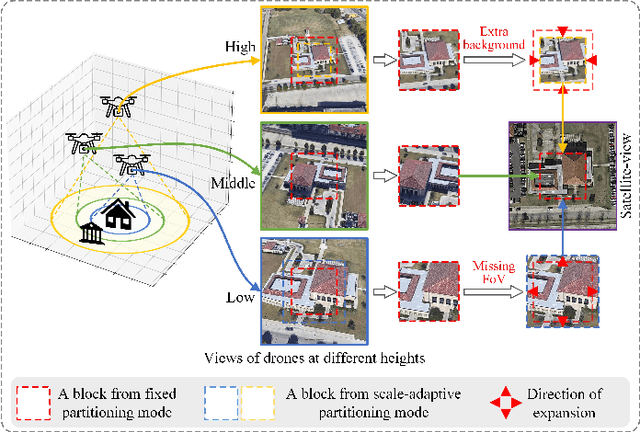

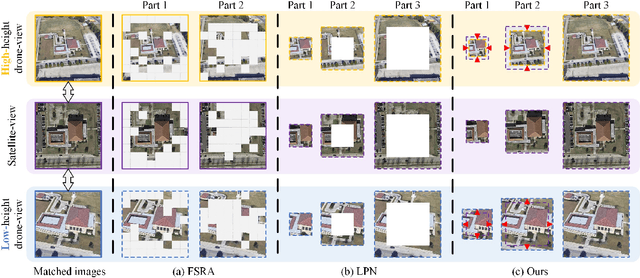

Abstract:UAV-view Geo-Localization~(UVGL) presents substantial challenges, particularly due to the disparity in visual appearance between drone-captured imagery and satellite perspectives. Existing methods usually assume consistent scaling factor across different views. Therefore, they adopt predefined partition alignment and extract viewpoint-invariant representation by constructing a variety of part-level features. However, the scaling assumption is not always hold in the real-world scenarios that variations of UAV flight state leads to the scale mismatch of cross-views, resulting in serious performance degradation. To overcome this issue, we propose a partition learning framework based on relative distance, which alleviates the dependence on scale consistency while mining fine-grained features. Specifically, we propose a distance guided dynamic partition learning strategy~(DGDPL), consisting of a square partition strategy and a distance-guided adjustment strategy. The former is utilized to extract fine-grained features and global features in a simple manner. The latter calculates the relative distance ratio between drone- and satellite-view to adjust the partition size, thereby explicitly aligning the semantic information between partition pairs. Furthermore, we propose a saliency-guided refinement strategy to refine part-level features, so as to further improve the retrieval accuracy. Extensive experiments show that our approach achieves superior geo-localization accuracy across various scale-inconsistent scenarios, and exhibits remarkable robustness against scale variations. The code will be released.
Near Large Far Small: Relative Distance Based Partition Learning for UAV-view Geo-Localization
Dec 16, 2024



Abstract:UAV-view Geo-Localization (UVGL) presents substantial challenges, primarily due to appearance differences between drone-view and satellite-view. Existing methods develop partition learning strategies aimed at mining more comprehensive information by constructing diverse part-level feature representations, which rely on consistent cross-view scales. However, variations of UAV flight state leads to the scale mismatch of cross-views, resulting in serious performance degradation of partition-based methods. To overcome this issue, we propose a partition learning framework based on relative distance, which alleviates the dependence on scale consistency while mining fine-grained features. Specifically, we propose a distance guided dynamic partition learning strategy (DGDPL), consisting of a square partition strategy and a dynamic-guided adjustment strategy. The former is utilized to extract fine-grained features and global features in a simple manner. The latter calculates the relative distance ratio between drone- and satellite-view to adjust the partition size, thereby aligning the semantic information between partition pairs. Furthermore, we propose a saliency-guided refinement strategy to refine part-level features, so as to further improve the retrieval accuracy. Extensive experiments show that our approach achieves superior geo-localization accuracy across various scale-inconsistent scenarios, and exhibits remarkable robustness against scale variations. The code will be released.
CLIP-SR: Collaborative Linguistic and Image Processing for Super-Resolution
Dec 16, 2024Abstract:Convolutional Neural Networks (CNNs) have advanced Image Super-Resolution (SR), but most CNN-based methods rely solely on pixel-based transformations, often leading to artifacts and blurring, particularly with severe downsampling (e.g., 8x or 16x). Recent text-guided SR methods attempt to leverage textual information for enhanced detail, but they frequently struggle with effective alignment, resulting in inconsistent semantic coherence. To address these limitations, we introduce a multi-modal semantic enhancement approach that combines textual semantics with visual features, effectively tackling semantic mismatches and detail loss in highly degraded LR images. Our proposed multi-modal collaborative framework enables the production of realistic and high-quality SR images at significant up-scaling factors. The framework integrates text and image inputs, employing a prompt predictor, Text-Image Fusion Block (TIFBlock), and Iterative Refinement Module alongside CLIP (Contrastive Language-Image Pretraining) features to guide a progressive enhancement process with fine-grained alignment. This alignment produces high-resolution outputs with crisp details and semantic coherence, even at large scaling factors. Through extensive comparative experiments and ablation studies, we validate the effectiveness of our approach. Additionally, by incorporating textual semantic guidance, our technique enables a degree of super-resolution editability while maintaining semantic coherence.
Towards Rich Emotions in 3D Avatars: A Text-to-3D Avatar Generation Benchmark
Dec 03, 2024



Abstract:Producing emotionally dynamic 3D facial avatars with text derived from spoken words (Emo3D) has been a pivotal research topic in 3D avatar generation. While progress has been made in general-purpose 3D avatar generation, the exploration of generating emotional 3D avatars remains scarce, primarily due to the complexities of identifying and rendering rich emotions from spoken words. This paper reexamines Emo3D generation and draws inspiration from human processes, breaking down Emo3D into two cascading steps: Text-to-3D Expression Mapping (T3DEM) and 3D Avatar Rendering (3DAR). T3DEM is the most crucial step in determining the quality of Emo3D generation and encompasses three key challenges: Expression Diversity, Emotion-Content Consistency, and Expression Fluidity. To address these challenges, we introduce a novel benchmark to advance research in Emo3D generation. First, we present EmoAva, a large-scale, high-quality dataset for T3DEM, comprising 15,000 text-to-3D expression mappings that characterize the aforementioned three challenges in Emo3D generation. Furthermore, we develop various metrics to effectively evaluate models against these identified challenges. Next, to effectively model the consistency, diversity, and fluidity of human expressions in the T3DEM step, we propose the Continuous Text-to-Expression Generator, which employs an autoregressive Conditional Variational Autoencoder for expression code generation, enhanced with Latent Temporal Attention and Expression-wise Attention mechanisms. Finally, to further enhance the 3DAR step on rendering higher-quality subtle expressions, we present the Globally-informed Gaussian Avatar (GiGA) model. GiGA incorporates a global information mechanism into 3D Gaussian representations, enabling the capture of subtle micro-expressions and seamless transitions between emotional states.
 Add to Chrome
Add to Chrome Add to Firefox
Add to Firefox Add to Edge
Add to Edge